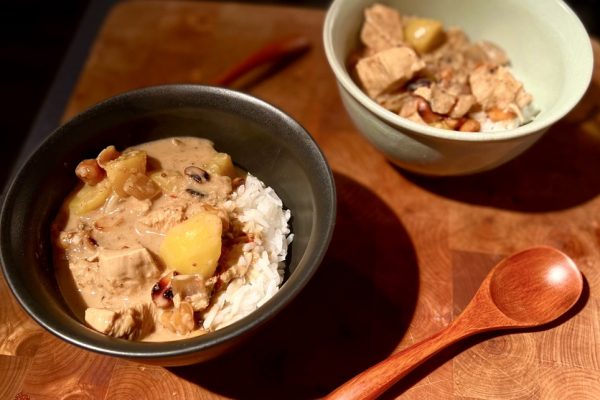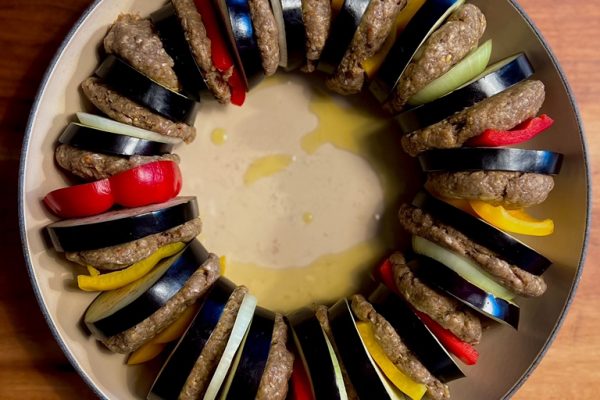Classic pasta shape and classic filling – what a treat! For filled pasta we use a pasta dough with a high proportion of egg. It makes the dough yellow, delicious and easy to stretch and work with.

Make a little mountain of flower and a little salt on your board – if you have one, use a wooden board, if not, use your kitchen table. With a little bowl you can shape a volcano. You will need some space for the amount of egg used in this recipe.

One twist in this recipe is adding half a spoon of white balsamic vinegar to the eggs, which gives the dough additional elasticity.

With a fork, whisk the eggs and gradually mix them with small amounts of the flour. The volcano ensures that the liquid egg does not run over your board.

Now some physical strength is needed. Work on the dough with both palms until it shapes an elastic, uniform ball.

The texture should resemble to that of a firm cheese.

This step takes a while. Be patient. You will be rewarded. If you are happy with your result, wrap the dough in a piece of cling film or put it into an airtight container. It is important that the dough does not dry out the resting time. The dough will need at least half an hour of rest. During this time, the connections the gluten has formed during your kneading process will relax.

Gluten – by the way – is truly a great thing. It is nothing to be afraid of. If you are not downright allergic (only few people are) enjoy its qualities. It gives the dough its structure, making it elastic and stretchy.
For the filling we use fresh organic mushrooms, a bunch of parsley, onion, parmesan cheese and breadcrumbs. For seasoning we use salt, pepper, dark balsamic vinegar (good, old and sweet, if possible) and – we do hope the Italians will not stone us – a little soy sauce. It brings out the earthy umami taste of the mushrooms extremely well.

We do not buy bread crumbs – when leftover bread dries out, you can easily turn it into good breadcrumbs with a food processor. You can store them for months in an airtight container.

Organic mushrooms from indoor cultivation usually do not need to be washed. If they are not too dirty, brushing them off is sufficient. It is a lot better to work with mushrooms not soaked in water.
Now we need to cut the mushrooms very finely. To do this, start by cutting the mushrooms in half.

Now cut them into thin slices. It helps to use a large cooking knife rather than a tiny knife (which is more practical for peeling or trimming).

Now you chop the mushrooms finely by working the knife through the slices with a rocking movement back and forth.

Wash and pat dry the parsley. Your pasta will be much more refined if you take the time to pluck off the leaves. The stems have a totally different texture. They can find better use in a soup or broth. The onions also have to diced in small cubes. How to do this easily, we describe here.

To sauté the onions, we use a mixture of butter and olive oil in equal parts. Use only moderate heat and take your time. Meanwhile, meditate over the unparalleled delicious smell of onions in butter. Simple and wonderful.

When you are happy with the result, add the mushrooms, the balsamic vinegar, salt, pepper and a splash of soy sauce. The mushrooms will now release an astonishing amount of liquid. Watch it disappear in steam slowly. When the water has disappeared almost completely, add the parsley, the grated parmesan cheese and the breadcrumbs. Remove the pan from the stove immediately and let the mixture cool down.

Now back to the pasta dough. Cut off a piece (the rest should always be protected from drying out again) and flatten it with a rolling pin.

You can now use a pasta machine or continue working with the rolling pin. Traditionally made pasta needs some time.

Through a machine you pass the dough several times, through each setting from thick to thin. Do not skip any setting in between. The dough is ready when it starts becoming a little transparent.

Now place small (half teaspoon sized) dollops of filling on the long side of your pasta strip (important: it must not be warm anymore!). Leave enough space between the heaps.

Fold the dough with the filling over from the outside so that you can press the edge cleanly onto the dough sheet. Now use your thumb and index finger to press the dough together between the heaps of filling, so that it looks like a chain of hills.

Now cut off the chain with a pastry wheel or a knife.

Now use the same tool to separate the agnolotti. If you always start from the same side, you will get the typical shape of this pasta, where the ends are folded forward and stick there.

If you want to watch a real master shaping agnolotti (and much more!), this is where to go.

Store your finished pasta on a lightly floured baking tray.

Cook the pasta in plenty of salted water. 4 to 5 minutes cooking time is enough. If you don’t want to eat it all at once, you can also freeze the pasta. However, you should also cook this pasta very briefly beforehand, because the raw dough sticks together incredibly quickly.

Melt some butter in a frying pan and add a few twigs of thyme for flavour.

When the pasta is ready, scoop it directly from the pot into the pan and thereby add some cooking liquid. It is an essential component of this dish, emulsifying with the butter by careful stirring and coating the pasta nicely. The right amount is neither dry nor watery.

Grate some parmesan cheese on top and your agnolotti pasta is ready!

Enjoy.
And may the taste be with you.
Ingredients (for 4 people):
Pasta dough:
300 g flour (special wheat flour for Pasta / Pizza – in Italy: Tipo 00)
120 g egg yolk
100 g full egg
Half a spoon of white vinegar
3 g salt
Filling:
200 g organic mushrooms
1 Onion
1 bunch of parsley
Breadcrumbs
Grated parmesan cheese
Some dark balsamic vinegar
Optional: A splash of soy sauce
Salt and Pepper to taste
Finalisation:
Olive oil and butter
Some twigs of thyme
Grated parmesan cheese





4 thoughts on “Agnolotti Pasta with Mushroom Filling”